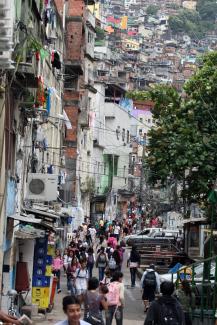Digital activism
Live from the favela
 picture-alliance/dpa
picture-alliance/dpa
When Google Maps launched its Street View of Rio de Janeiro, Brazilians were shocked. Hundreds of slums appeared on computer screens, diverting attention from sights like Sugarloaf Mountain and Christ the Redeemer. Many Brazilians studying Rio on Google Maps were surprised to discover that the city looks like a massive collection of favelas.
That is the truth, of course, though this truth was suppressed in the past for image reasons and for lack of access to drug-gang controlled settlements. Around a quarter of Rio’s 6.3 million people live in slums. For decades, city maps simply did not show some 1,000 favelas on the slopes of Rio’s rich south Zone and the city’s poor north.
When the Brazilian media used to report from favelas, the focus was mostly on violence, poverty and drug trafficking. But thanks to the Internet, those who live in the favelas can now spread their own views of what their lives are like, interacting the outside world and shaping more positive perceptions.
Dandara Couto Rodrigues regularly patrols her neighbourhood, the favela Complexo da Maré, in the north of Rio. Armed with a GPS cell phone, the 23-year old volunteer photographs points of interest and uploads the images along with location details and other information to WikiMapa, a collaborative online map. The joint effort provides an overview of churches, hospitals, schools, sports centres, organisations, restaurants, bars, bus stops, shops and streets in five of Rio's favelas: Complexo da Maré, Cidade de Deus, Santa Marta, Pavão Pavãozinho and Complexo do Alemão.
This online map is one of the projects run by the Rede Jovem ("Youth Network"), an initiative that has been harnessing new technologies, especially the Internet, to drive social progress in the favelas since 2000. Over the past two years, five full-time wiki-reporters and more than 700 volunteers have added thousands of details to WikiMapa.
The virtual map helps those who live in the favelas to find and make use of local services. But the organisations, initiatives and businesses listed by WikiMapa also send a message to the outside world: They are proof of the creative potential that exists out of mainstream society’s sight in the favelas.
Ahead of the 2014 FIFA World Cup and 2016 Olympic Games, Rio is beginning to attract more tourists, many of whom wish to see the favelas. Anyone venturing into the slums without a tour guide can use WikiMapa to find their way through the labyrinth of streets and narrow alleys.
Blogspots
In Rocinha, 49-year-old Zezinho has been covering neighbourhood developments on his online webblog in English for the past three years. "I am proud to be a favelado and want to share my life with the world," he says. Zezinho wants to improve the image of the favelas: "The media constantly spread negative perceptions of our neighbourhoods in the news, so people outside get very little accurate information."
His "Life in Rocinha“ blog discusses things like his DJ school for young people and publishes short interviews with tourists who speak of their impressions and experiences. Zezinho also reflects on the social barriers and stereotypes with which he grew up.
He is not the only one who is using the Internet to overcome social marginalisation and develop new business ideas. Many favelados now go online to draw attention to their projects or commercial ventures. Tourist guides, estate agents and retailers are present on Facebook; young photographers from the favelas post samples of their work on Facebook and Flickr.
Some favelas have a long tradition of citizen journalism. Today, community newspapers and community radios host online portals which enable them to reach out to a larger audience outside the favela.
- O Cidadão ("The Citizen") was one of the first of such publications in Complexo da Maré. Etablished in 1999, it now has its own weblog.
- Seven years ago, Rene Silva, who is now 18 years old, started the newspaper Voz da Comunidade ("Voice of the Community"). It now has 6,000 fans on Facebook and nearly 100,000 followers on Twitter.
- The ANF news agency is another digital voice from the favelas. Set up by André Fernandes in 2001, its ambition is to create an international network of correspondents covering urban development problems (see Elton Hubner "Marginalised voices" in D+C/E+Z 2011/11 p. 434 f.).
"I like Twitter and Facebook“, says Rene Silva. "I see social networks as a way to communicate with people very fast." He uses Facebook and Twitter, for instance to appeal for donations of school materials for favela children. Other tweets serve to make politicians and officialdome aware of leaking water pipes or other unacceptable civic grievances.
Silva is on the Internet almost all day long, relying on a smartphone or a laptop provided by business sponsors. "Not everyone's home is connected to the Internet," Silva points out, "but people use mobile phones or go to Internet cafés."
The government is pleased to see the Internet helping to open up the favelas. Since 2003, policy has been shaped by the centre-left Workers’ Party. Its candidate at that time, Lula da Silva, became president. He and his successor Dilma Rousseff, who has been in office since 2011, set their sights on reducing poverty and creating opportunities for disadvantaged Brazilians.
Thanks to Brazil’s booming economy, there is a huge demand for skilled labour. And there are new opportunities for upward mobility. Improving living conditions in the favelas has indeed become a key to economic development because poor people will never be able to upgrade their skills or acquire new ones unless they live in stable conditions.
Obviously, Brazil is also investing in the favelas to prepare for the Football World Cup and the Olympics. The government does not want the country’s reputation to be sullied by slums and criminal gangs. A mixture of strict law enforcement and security efforts on the one hand, and urban improvement with new schools, libraries, sports facilities et cetera on the other, is meant to promote social progress in strategically important favelas.
Free WLAN
The government has even set up free wireless Internet networks in some favelas, and it offers Internet courses for the people who live there. But the connections are allegedly unreliable, and not everyone owns a computer or a smartphone.
In Cidade de Deus, almost half of the population has a computer; in Rocinha, however, blogger Zezinho estimates the share is not more than 20%. "Internet cafés are important," says Zezinho. The first of its kind was established in Rocinha around 2004; today, there are more than 80 "LAN houses" that offer affordable Internet access.
Zezinho has had a laptop of his own for two years now. Rocinha’s free wireless network only reaches his roof; he generally uses a modem. The connection is slow, he says, but it works "95 % of the time". He concedes: "I have problems connecting in heavy rain or when there is a strong wind – and a total power failure will occur maybe three times a year."
Sonja Peteranderl reports from Latin America as a freelance journalist
sonja.peteranderl@gmail.com
